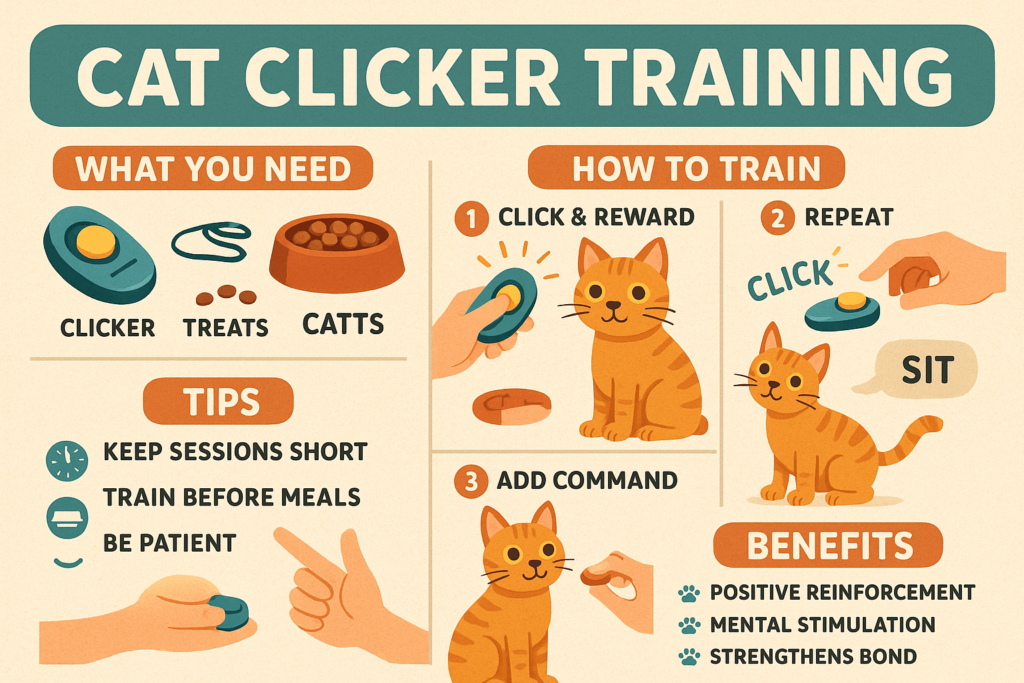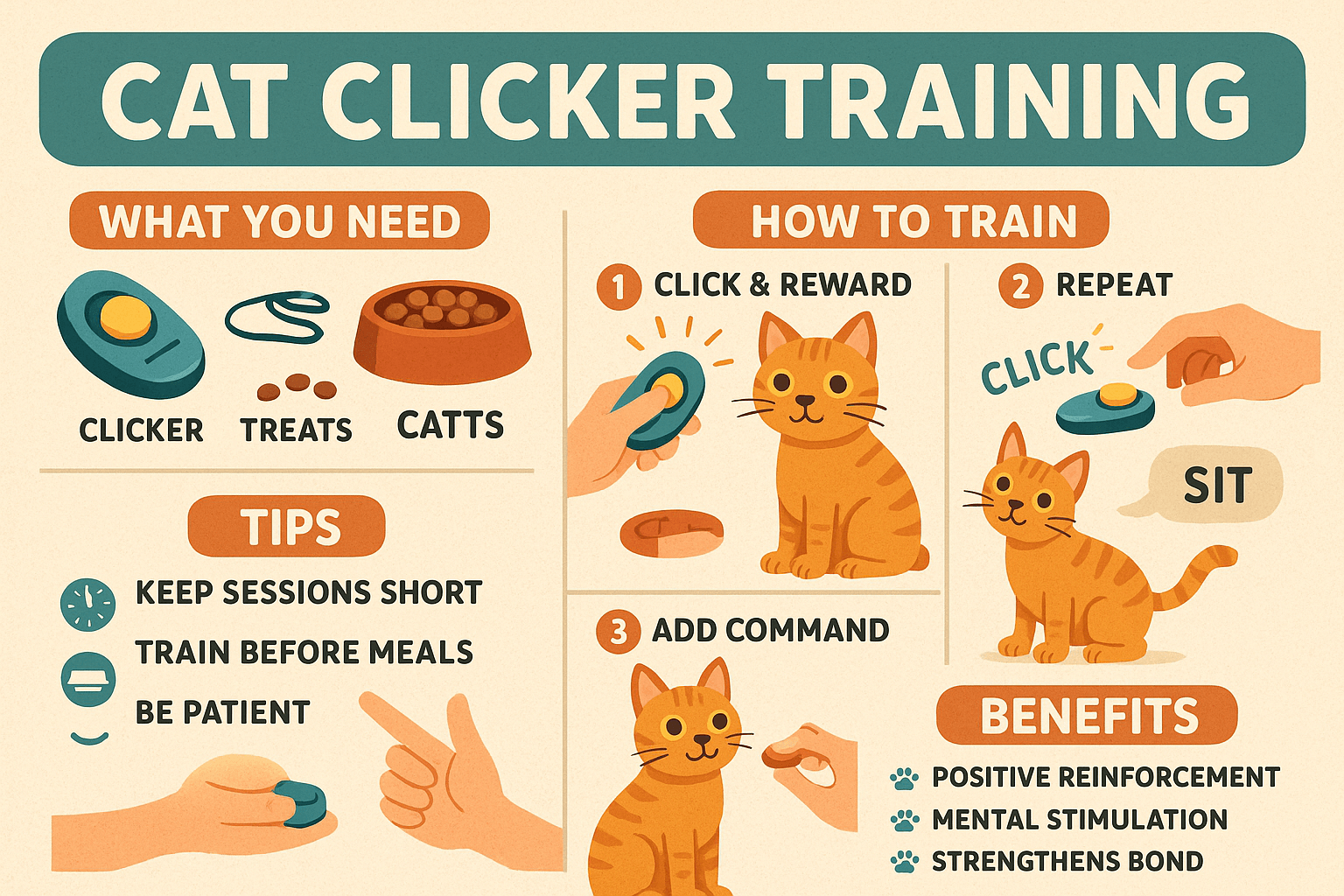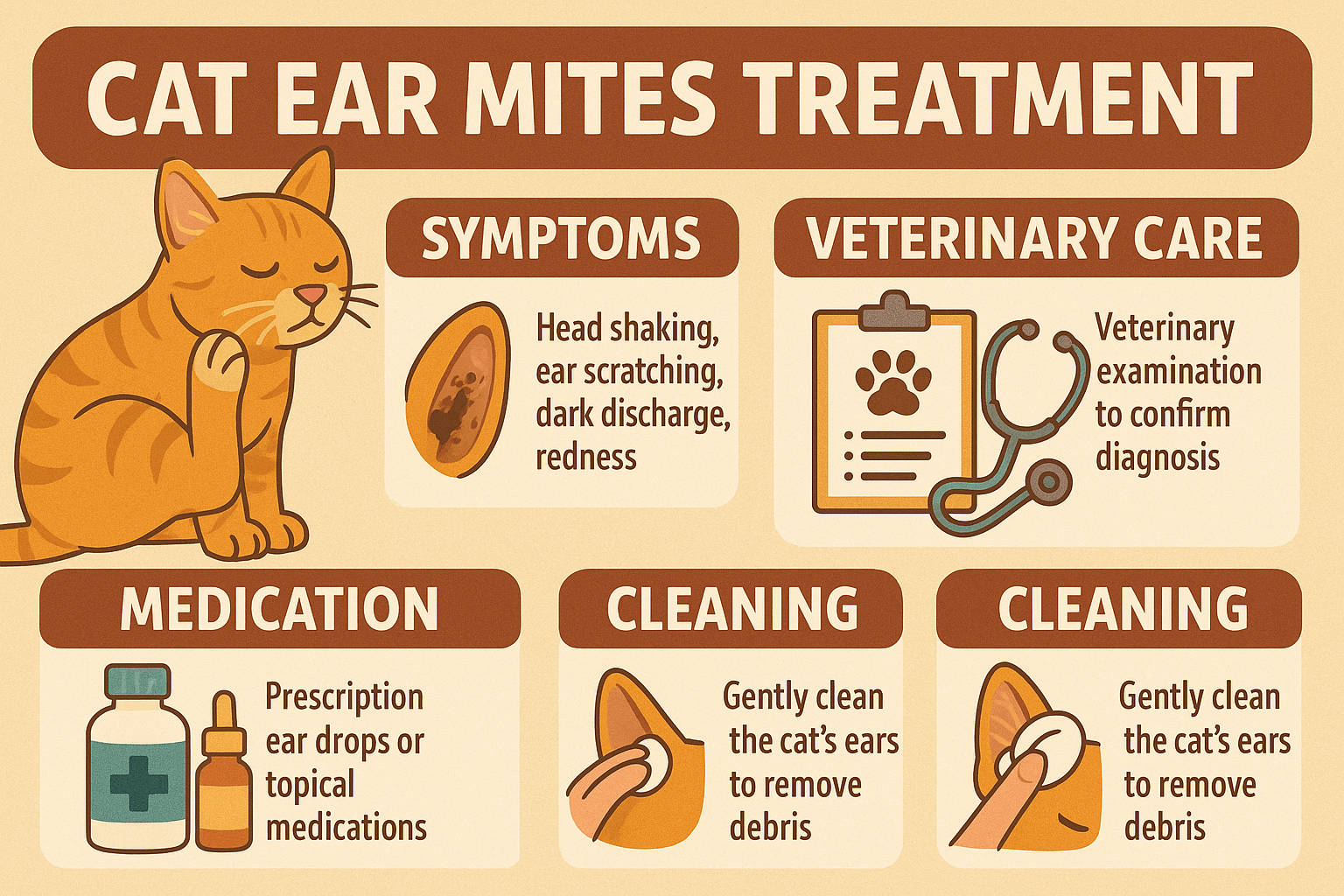Cat Clicker Training: Unlocking Your Feline’s Potential
Clicker training isn’t just for dogs—cats can benefit from this positive reinforcement technique too! While many people assume cats are untrainable due to their independent nature, clicker training proves otherwise. This method uses a small clicking device paired with rewards to teach your cat new behaviors, strengthen your bond, and provide mental stimulation. Whether you want to teach tricks, improve communication, or address behavioral issues, clicker training is a fun and effective way to engage your feline friend. Let’s dive into the world of cat clicker training and discover how you can unlock your cat’s potential step by step.
How Clicker Training Works for Cats
Clicker training relies on the principles of positive reinforcement, rewarding desired behaviors to encourage repetition. Understanding the basics will set you up for success when working with your cat.
The Click Marks the Moment:
The clicker sound pinpoints the exact behavior you’re rewarding, helping your cat understand what they did right.Immediate Rewards Are Key:
After each click, offer a treat or praise to reinforce the connection between the behavior and the reward.Keep Sessions Short and Fun:
Cats have short attention spans, so limit sessions to 5-10 minutes to maintain their interest and enthusiasm.Start with Simple Behaviors:
Begin with easy actions like sitting or touching a target stick before progressing to more complex tricks.Be Consistent and Patient:
Cats learn at their own pace, so consistency and patience are essential for building trust and confidence.
By mastering these fundamentals, you’ll create a positive learning environment that motivates your cat to participate willingly.

Benefits of Clicker Training for Cats
Beyond teaching tricks, clicker training offers numerous benefits that enhance your cat’s well-being and strengthen your relationship. Here’s why it’s worth incorporating into your routine.
Improves Communication:
Clicker training helps you communicate clearly with your cat, making it easier to guide their behavior in everyday situations.Boosts Mental Stimulation:
Learning new skills keeps your cat mentally sharp and prevents boredom, which can lead to destructive behaviors.Strengthens Your Bond:
Positive interactions during training build trust and deepen the connection between you and your cat.Addresses Behavioral Issues:
Clicker training can redirect unwanted behaviors, such as scratching furniture or jumping on counters, by teaching alternative actions.Encourages Confidence:
Successfully completing tasks boosts your cat’s self-esteem, especially for shy or anxious felines.
With so many advantages, clicker training is a win-win for both you and your furry companion.
Check this guide 👉Discover the Magic of Cat Training Spray: Best 7 Expert Tips
Check this guide 👉Can You Potty Train a Cat? Best 7 Expert Tips!
Check this guide 👉How to Train a Cat to Sit: Best 7 Expert Tips!
Basic Supplies for Cat Clicker Training | Common Tricks to Teach Your Cat |
|---|---|
Clicker device | High five |
Small, tasty treats | Spin in a circle |
Target stick or wand | Jump through a hoop |
Quiet, distraction-free space | Come when called |
Patience and consistency | Play dead |
Step-by-Step Guide to Start Clicker Training
Getting started with clicker training is simple if you follow a structured approach. These steps will help you introduce the concept to your cat and build a foundation for future learning.
Introduce the Clicker Sound:
Click the device and immediately give your cat a treat. Repeat several times until they associate the sound with a reward.Choose a Simple Behavior to Reward:
Focus on natural actions, like sitting or looking at you, to make the process easier for your cat to grasp.Mark the Desired Action with a Click:
As soon as your cat performs the behavior, click to mark the moment and follow up with a treat.Add a Verbal Cue or Hand Signal:
Once your cat consistently performs the behavior, introduce a cue word or gesture to pair with the action.Gradually Increase Difficulty:
After mastering basic behaviors, challenge your cat with more advanced tricks or multi-step commands.
By following these steps, you’ll create a positive and engaging learning experience for your cat.
Tips for Success During Clicker Training
To maximize the effectiveness of clicker training, keep these practical tips in mind. They’ll help you overcome challenges and ensure a smooth learning process.
Use High-Value Treats:
Choose treats your cat loves, such as freeze-dried chicken or tuna, to motivate them during training.Train When Your Cat Is Hungry:
A slightly hungry cat is more likely to focus on earning treats, making sessions more productive.End on a Positive Note:
Always finish with a successful trick or behavior to leave your cat feeling accomplished and eager to return.Avoid Punishment:
Negative reactions can damage your cat’s trust and discourage participation. Stick to positive reinforcement only.Celebrate Small Wins:
Acknowledge progress, even if it’s incremental, to keep your cat motivated and confident in their abilities.
These strategies will enhance your training sessions and foster a joyful learning atmosphere.
Common Challenges and Solutions
While clicker training is highly effective, you may encounter obstacles along the way. Here are some common challenges and how to address them.
Lack of Interest from Your Cat:
Try using higher-value treats or training during quieter times when distractions are minimal.Difficulty Focusing for Long Periods:
Break sessions into shorter intervals and gradually increase duration as your cat becomes more engaged.Inconsistent Responses to Cues:
Ensure you’re always pairing the verbal cue or hand signal with the correct behavior to avoid confusion.Overfeeding During Training:
Use tiny pieces of treats or incorporate part of their daily food allowance to prevent overfeeding.Progress Slows Over Time:
Introduce new challenges or vary the rewards to reignite your cat’s motivation and curiosity.
By addressing these challenges proactively, you’ll keep your cat excited and eager to learn.
Fun Tricks to Try After Mastering Basics
Once your cat has mastered foundational behaviors, you can move on to more exciting tricks. These ideas will keep training sessions fresh and entertaining.
Fetch with Toys:
Encourage your cat to retrieve small toys by rewarding them each time they bring one back to you.Walking on a Leash:
Use clicker training to introduce leash walking gradually, rewarding calm behavior during outings.Paw Shake or Fist Bump:
Teach your cat to lift their paw and gently touch your hand for a playful “shake” or “bump.”Nose Touch to Target Objects:
Train your cat to touch their nose to specific objects, like a ball or stick, for interactive play.Open a Drawer or Door:
With patience, you can teach your cat to pull open lightweight drawers or doors using a rope or handle.
These creative tricks showcase your cat’s intelligence and add variety to your training routine.
Incorporating Clicker Training into Daily Life
Clicker training doesn’t have to be limited to formal sessions—you can integrate it seamlessly into your daily routine. Here’s how to weave it into everyday activities.
Mealtime Engagement:
Use the clicker to reward your cat for polite behavior, like sitting patiently while you prepare their food.Redirecting Scratching Habits:
Train your cat to use a scratching post instead of furniture by clicking and rewarding whenever they choose the correct surface.Grooming Assistance:
Click and treat your cat for staying calm during brushing or nail trimming to make grooming less stressful.Visiting New Spaces:
Reinforce confident exploration of unfamiliar areas, like a carrier or guest room, with clicks and rewards.Building Confidence Around Strangers:
Encourage calm interactions with visitors by rewarding friendly behavior toward guests.
By incorporating clicker training into daily life, you’ll reinforce good habits and create a harmonious living environment for both you and your cat.
Frequently Asked Questions About Cat Clicker Training
Can all cats be trained using a clicker?
Yes, most cats can learn through clicker training, though some may take longer than others depending on their personality.
What if my cat loses interest during training?
If your cat seems disengaged, shorten the session or try again later when they’re more alert and receptive.
Do I need a specific type of clicker?
Any consistent noise-making device, such as a store-bought clicker or a pen click, works as long as it’s distinct and clear.
How long does it take to see results?
Results vary, but many cats begin responding within a few sessions if trained consistently.
Can clicker training help with litter box issues?
While not a direct solution, clicker training can redirect undesirable behaviors and reinforce positive habits.
Empowering Your Cat Through Clicker Training
Clicker training is a powerful tool that empowers your cat while strengthening your bond. By combining positive reinforcement, patience, and creativity, you can teach your feline friend impressive tricks and valuable life skills. Beyond the fun and games, this method enriches your cat’s life, providing mental stimulation and boosting their confidence. With dedication and consistency, you’ll be amazed at what your cat can achieve. So grab a clicker, stock up on treats, and embark on this rewarding journey together—it’s time to discover just how clever your cat truly is!
Cat Clicker Training: Best 7 Expert Tips! Discover how to train your cat using clicker techniques, improve behavior, and strengthen your bond with simple, effective strategies.
Lorem ipsum dolor sit amet, consectetur adipiscing elit. Ut elit tellus, luctus nec ullamcorper mattis, pulvinar dapibus leo.
Cat Ear Mites Treatment: Best 7 Expert Tips! Discover effective solutions to treat and prevent ear mites in cats, ensuring your pet's comfort and health with expert advice.
Cat Acne Treatment: Best 7 Expert Tips! Discover effective remedies, prevention strategies, and expert advice to treat and manage feline acne for a healthier, happier cat.



